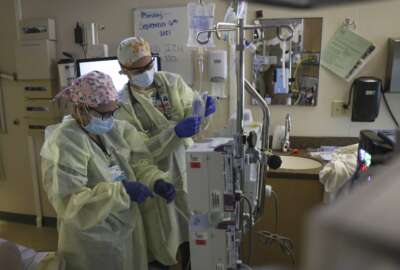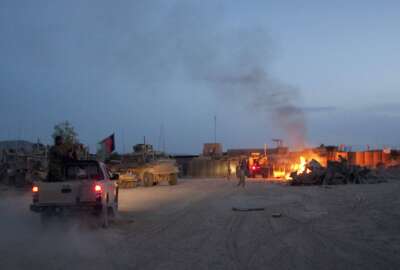VA responds to veterans’ demands for green internment
Three of the Veterans Affairs' national cemeteries opened green burial sections last month. Green burials are possible for both cremated and intact remains.
Veterans who wish to be buried with the least environmental impact now have a new option. Three of the Veterans Affairs’ national cemeteries opened green burial sections last month. Green burials are possible for both cremated and intact remains. Lisa Pozzebon, executive director of cemetery operations for the VA, joined the Federal Drive with Tom Temin for details.
Interview transcript:
Tom Temin: And let’s define the terms here. What is a green burial?
Lisa Pozzebon: So generally, a green burial refers to an environmentally friendly method of burial. And it’s characterized by not using chemicals, concrete vaults or other nonbiodegradable materials. And sometimes you might hear it referred to as a natural burial. So for us within VA, we have what we’re calling green burial sections. And so our requirements for burial in one of those sections follows that those general requirements that the remains are prepared that do not involve the use of chemicals or embalming fluids and that the remains are interred in a natural manner, in a completely biodegradable receptacle, such as a casket orinner.
Tom Temin: It’s almost as if you’re following the standards that many Jewish and Muslim people follow.
Lisa Pozzebon: Good point. Because while these green burial sections are new to NCA, there are certainly aspects of green burial that we have accommodated and allowed in our cemeteries today, such as a biodegradable container. So whether it be a casket or urn and we also do not require currently remains to be embalmed. The main difference is that families that choose aspects of a natural burial will be interred either in-ground in a casket or in-ground cremains section or above ground in one of our columbarium niches. And those are maintained like we do all other sections. So they do not have some of the same characteristics that are green burial sections will have.
Tom Temin: And it’s OK to do burial of intact remains in this manner publicly and in the ground. I mean, there’s no groundwater or well issues.
Lisa Pozzebon: Absolutely not. We get that question a lot that there is concern. It’s actually the most natural method. How the remains were buried many years ago versus the chemicals that are used or the metals in the concrete that are a part of what has become the burial process in some cases.
Tom Temin: Sure.
Lisa Pozzebon: So definitely cleaner.
Tom Temin: And if again, sticking with the intact idea, then there is usually the urgency to get the burial done quickly after the person passes.
Lisa Pozzebon: Correct. It’s usually the state that is controlling how remains are held. And if embalming is not done. Funeral directors have a responsibility to be storing remains in a particular way that helps to preserve them, even if chemicals are not used. We understand that when a family is choosing not to embalm and is looking for a natural burial option, they are likely to want to do so in a reasonably fast manner. And while we can’t guarantee that next day burial will always be an option, we will do our best to accommodate once the family calls and establishes or through their funeral home calls and establishes their eligibility and request scheduling.
Tom Temin: We’re speaking with Lisa Pozzebon. She’s executive director of cemetery operations at Veterans Affairs Department. I guess it’s the Veterans Cemetery Administration, specifically the third leg of VA that’s a little bit smaller than the other two big ones. Tell us more about this particular program. Which cemeteries have these areas and what is the capacity within those cemeteries?
Lisa Pozzebon: So we have three cemeteries that currently have green burial sections established and open for interment. And those are Florida National Cemetery in Bushnell, Florida. It’s east of Orlando. We have one in Pikes Peak National Cemetery in Colorado Springs, Colorado, and the National Memorial Cemetery of Arizona in Phoenix. So all three of those are currently accepting burials in a green burial section.
Tom Temin: And how big are the green burial sections?
Lisa Pozzebon: So the green burial sections are, I would say, a little smaller. They accommodate across the three and the three are each a little different. They can accommodate anywhere from 100 to 200 burials in those sections.
Tom Temin: And just to give us a sense of scale, how large are those cemeteries?
Lisa Pozzebon: Florida National and National Memorial Cemetery of Arizona are both decades-long established cemeteries. And they each both have thousands of grave sites already established across multiple sections. Pikes Peak is the newest of our cemeteries. Of those three, they’re still growing. They may have a thousand by now, but are certainly much smaller than the other two.
Tom Temin: And what is the demand? How do you know how many people can you plan for VA, for veteran burials?
Lisa Pozzebon: Well, and that is part of what we’re looking to gain by piloting this program to find out what the demand for green burials is. We know that at these cemeteries, particularly Pikes Peak in Florida, have gotten interest as have some of our other cemeteries as well. People inquire about do you offer this option? What are our options? It’s hard to gage because at the time someone passes and other family members are involved in what choices people make may differ from what they’re asking about. But one of the things that we are doing, we annually do a customer satisfaction survey that surveys both families as well as funeral homes. And we’ve added a question for funeral homes to get a sense of how often they’re getting requests for green burials. So that information will help us in the future to understand where are we getting populations of veterans who are into seem more interested in pursuing a green burial option.
Tom Temin: And why do green burials need to be in a segregated section? Why can’t if it’s all the same that goes into the ground, why not right next to where there’s a steel coffin and a concrete pan?
Lisa Pozzebon: So one of the things with the green burial section and beyond how the remains are prepared and in the receptacle that they’re interred in, these sections have a unique appearance. For one, they are going to be and are maintained with a more natural aesthetic using natural grasses that you might find more in that area. And as you could imagine, the difference between Arizona, Colorado and Florida, those three cemeteries, those burial sections are very different as well from each other. In fact, in Arizona, it’s in a desert setting. That cemetery is one of our cemeteries where we use decomposed granite as their escape. And so there are very limited plantings. There are some cacti throughout the cemetery and in a few desert plants. But it is a very different environment than, say, the prairie setting you kind of find in Pikes Peak in Colorado Springs. So they’re very different. We also are in maintaining those sections, minimizing the use of fertilizers, pesticide and irrigation in keeping with the natural environment. We also have a unique marker that we are using in those sections, a lower profile marker that has a more natural appearance that will fit in with that environment. The other thing that you might notice too, because again, given the nature of the type of burial, our practice for, say, intact remains, when we inter, we will be mounting soil. So if you’ve ever been to a cemetery and after an interment, everything’s level, they may roll sod back on and it almost looks like nothing happened. In these green burial sections, you will see more of a mounded almost barrel shape over the designated gravesite because we’re allowing for the natural settling and decomposition and it’ll eventually kind of level out, but to allow the natural process to occur. Some differences.
Tom Temin: If you want that putting green look, you’d have to go to the conventional section. And if you want a little more naturalistic looking like a meadow, then you would go to the green.
Lisa Pozzebon: Yeah, exactly. A more manicured turf. Certainly.
Copyright © 2025 Federal News Network. All rights reserved. This website is not intended for users located within the European Economic Area.
Tom Temin is host of the Federal Drive and has been providing insight on federal technology and management issues for more than 30 years.
Follow @tteminWFED






